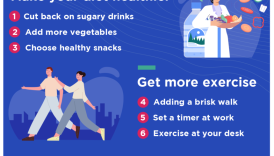Embracing a Healthier Lifestyle: Where to Begin

Importance of a Healthy Lifestyle
In today’s fast-paced world, it’s easy to prioritize convenience over health. With takeout options just a few taps away and sedentary activities at our fingertips, many find themselves neglecting the fundamental elements of a healthy lifestyle. However, adopting healthy habits is not merely a trend—it’s a necessity. A healthy lifestyle serves as the foundation for overall well-being. It goes beyond physical health, encompassing mental, emotional, and social wellness. For instance, consider someone who dedicates time to physical activity, eats nutritious meals, and prioritizes sleep. This individual is likely to experience improved energy levels, enhanced mood, and better resilience to stress.
- Embracing a Healthier Lifestyle: Where to Begin
- Importance of a Healthy Lifestyle
- Benefits of Embracing Healthier Habits
- Evaluating Your Current Health
- Understanding Your Body Mass Index (BMI)
- Assessing Your Nutritional Intake
- Setting Realistic Health Goals
- Creating a Balanced Fitness Plan
- Establishing a Sustainable Diet Plan
- Making Time for Physical Activity
- Finding Activities You Enjoy
- Incorporating Exercise into Your Daily Routine
- Prioritizing Mental Health and Wellness
- Practicing Mindfulness and Meditation
- Seeking Professional Support when Needed
Benefits of Embracing Healthier Habits
Integrating healthier habits into daily life can lead to a myriad of benefits. Here are some compelling reasons to embrace this lifestyle change:
- Improved Physical Health: Regular exercise and a balanced diet can help maintain a healthy weight, reduce the risk of chronic diseases, and enhance cardiovascular health.
- Enhanced Mental Clarity: Exercise releases endorphins—commonly known as the feel-good hormones—that can lift mood and sharpen focus.
- Increased Energy Levels: Contrary to popular belief, exercising regularly actually enhances energy levels. After a brisk walk or workout session, many individuals report feeling invigorated.
- Stronger Immune System: A nutritious diet coupled with regular physical activity can boost immunity, helping fend off common illnesses.
- Better Sleep Quality: Engaging in physical activity has been linked to improved sleep patterns, promoting deeper and more restorative rest.
For example, after implementing a morning jog routine, one might find that not only does their energy surge but they also enjoy greater productivity throughout the day. By recognizing the importance of a healthy lifestyle and the benefits of adopting healthier habits, individuals can take significant strides toward enhancing their quality of life. The journey towards well-being starts with small, deliberate choices that compound over time, leading to a more fulfilling and vibrant existence.
Evaluating Your Current Health
Understanding Your Body Mass Index (BMI)
To embark on the journey toward better health, it’s crucial to take stock of your current health status. One effective tool for assessing your body weight relative to height is the Body Mass Index (BMI). Calculating your BMI can provide valuable insights into whether you’re in a healthy range. BMI is calculated using the formula: [ \textBMI = \frac\textweight (kg)(\textheight (m))^2 ] The results fall into the following categories:
- Underweight: BMI less than 18.5
- Normal weight: BMI 18.5 to 24.9
- Overweight: BMI 25 to 29.9
- Obesity: BMI 30 or greater
For example, Lisa, a 5’4″ tall individual who weighs 140 pounds, calculates her BMI as follows:
- Convert weight to kilograms: 140 lbs ÷ 2.2 = 63.64 kg.
- Convert height to meters: 5’4″ = 1.63 m.
- Calculate BMI: 63.64 ÷ (1.63 × 1.63) = 23.9.
With a BMI of 23.9, Lisa falls within the normal weight range, indicating a healthy balance for her height.
Assessing Your Nutritional Intake
While BMI offers a snapshot of physical health, understanding nutritional intake provides deeper insights into overall well-being. Evaluating what you eat can help identify areas for improvement. Consider keeping a food diary for a week. Document everything consumed, including meals, snacks, and beverages. Once you have your food diary, analyze it based on these criteria:
- Fruits and Vegetables: Are you consuming at least 5 servings a day?
- Whole Grains: Are whole grains a staple in your diet?
- Protein Sources: Are you incorporating lean proteins, both plant-based and animal-based?
- Sugar and Sodium Intake: Are you aware of your added sugar and salt consumption?
For instance, Jake noticed through his food diary that he was loading up on sugary snacks but rarely ate vegetables. With this realization, he shifted his diet toward healthier options, incorporating more leafy greens and fruits into his meals. Evaluating your current health through BMI and dietary assessment equips you with knowledge and a clearer path to achieve your health goals, ensuring your journey to wellness is both informed and sustainable.
Setting Realistic Health Goals
Creating a Balanced Fitness Plan
Having evaluated your current health, the next step is to set realistic health goals that can guide your journey to a healthier lifestyle. A key aspect of this process is creating a balanced fitness plan that aligns with your personal interests and daily commitments. Start by considering what activities you enjoy. This could range from jogging and cycling to dancing or yoga. Enjoying your workouts will increase the likelihood of sticking with them. Here’s a simple framework to help you create your balanced fitness plan:
- Set Clear Goals: Instead of vague targets like “get fit,” opt for specific objectives such as “exercise for 30 minutes a day, five times a week.”
- Choose Activities: Select a mix of cardiovascular, strength, flexibility, and balance exercises.
- Schedule Your Workouts: Treat your workouts as appointments. Block out specific times in your calendar to ensure consistency.
- Mix It Up: Incorporate variety to keep workouts exciting. For example, alternate between running, cycling, and a fitness class.
For instance, Ben, who initially dreaded jogging, found joy in a local dance class. This not only improved his fitness but also made exercising something he looked forward to.
Establishing a Sustainable Diet Plan
Alongside a balanced fitness plan, establishing a sustainable diet plan is equally crucial. A sustainable diet focuses on nourishing your body without feeling deprived. Here are some tips to help guide your dietary choices:
- Focus on Whole Foods: Emphasize fruits, vegetables, whole grains, and lean proteins. These nutrient-dense options can help you feel fuller longer.
- Plan Your Meals: Set aside time each week to plan meals. This can help you avoid last-minute unhealthy choices.
- Practice Portion Control: Familiarize yourself with serving sizes and use smaller plates to avoid overeating.
- Stay Hydrated: Incorporating plenty of water into your daily routine is essential for overall health. Aim for at least eight glasses a day.
Sam found success in meal prepping every Sunday, allowing him to remain disciplined during the week. Packing healthy lunches and snacks made choosing nutritious foods much easier. By creating a balanced fitness plan and a sustainable diet plan, your health goals can become manageable and enjoyable. This holistic approach not only sets you up for success but also fosters a lasting relationship with health and wellness.
Making Time for Physical Activity
Finding Activities You Enjoy
As crucial as it is to set realistic health goals, the next step is ensuring that physical activity fits seamlessly into your life. This begins with finding activities that you genuinely enjoy. When exercise feels like a chore, it’s much harder to commit to it long term. By focusing on enjoyable activities, you can create a positive relationship with fitness. Consider trying out various sports or classes to discover what resonates with you. Here are some tips to help you find your groove:
- Experiment: Attend a few different classes, such as Zumba, yoga, or martial arts, to see what excites you.
- Outdoor Fun: Hiking, biking, or even a leisurely walk in the park can provide both physical activity and enjoyment of nature.
- Group Activities: Join a local sports team or exercise group. The social aspect can make the experience more enjoyable and motivating.
For example, Sarah was hesitant to join her friend’s kickboxing class, thinking it wouldn’t suit her. However, after trying it, she discovered a newfound passion for fitness and a welcoming community that made working out fun.
Incorporating Exercise into Your Daily Routine
Once you’ve identified activities you enjoy, the next challenge is making time for them within your daily routine. Here’s how you can incorporate exercise seamlessly:
- Start Small: Aim for short workouts initially. Even 10-15 minute sessions can be effective, especially when you’re just starting.
- Create Mini-Workouts: Build activity into your day with brief bursts of exercise—take the stairs instead of the elevator or park further away to squeeze in more walking.
- Routine Integration: Incorporate physical activity into daily tasks. You can do squats while cooking or lunges during commercial breaks.
- Schedule it In: Block out specific times for exercise in your calendar, just like any other important appointment.
Tom, a busy professional, found that he could squeeze a workout into his routine by doing short HIIT sessions during his lunch break. As a result, he felt energized and more focused for the rest of the day. By finding activities you enjoy and integrating them into your daily routine, physical activity can become an effortless and rewarding part of your life. This not only enhances your fitness journey but also empowers you to maintain a healthy lifestyle in the long run.
Prioritizing Mental Health and Wellness
Practicing Mindfulness and Meditation
While physical health is essential, mental health and wellness are equally pivotal to overall well-being. In today’s fast-paced world, it’s easy to feel overwhelmed or stressed. Integrating mindfulness and meditation into your routine can be an effective way to prioritize mental wellness. Mindfulness involves being fully present in the moment, allowing you to observe your thoughts and feelings without judgment. Meditation, on the other hand, can involve various techniques aimed at achieving a calm, focused state. Here are some strategies to help you get started:
- Start Small: Begin with just five minutes a day. Gradually increase the duration as you become more comfortable.
- Use Guided Meditations: Apps like Headspace or Calm offer guided sessions that can help you develop the practice more easily.
- Practice Mindful Breathing: Take a few moments throughout your day to focus on your breath. Inhale deeply through your nose, hold for a few seconds, and exhale slowly through your mouth.
For instance, Emily realized that dedicating just ten minutes each morning to mindfulness meditation significantly reduced her anxiety levels and set a positive tone for the day. By practicing presence, she found clarity in everyday tasks and better emotional regulation.
Seeking Professional Support when Needed
While self-help techniques like mindfulness and meditation can be incredibly beneficial, sometimes professional support is necessary. There is no shame in seeking help when needed; in fact, it can be one of the most proactive steps you can take for your mental health. Consider these pointers when contemplating professional support:
- Identify Signs That You Need Help: Persistent sadness, anxiety that interferes with daily life, or overwhelming stress can be indicators that it’s time to seek support.
- Explore Different Options: Therapy can take various forms—individual therapy, group therapy, or even online counseling. Find what feels most comfortable for you.
- Communicate Openly: Sharing your thoughts and feelings with a mental health professional can foster healing and new perspectives.
For example, Mark found himself feeling increasingly overwhelmed with work and personal responsibilities. After seeking therapy, he gained valuable coping strategies and felt less isolated in his struggles. Prioritizing mental health through mindfulness practices and professional support lays the foundation for a balanced life. It not only complements physical wellness but enhances overall quality of life, allowing individuals to flourish both mentally and emotionally.




